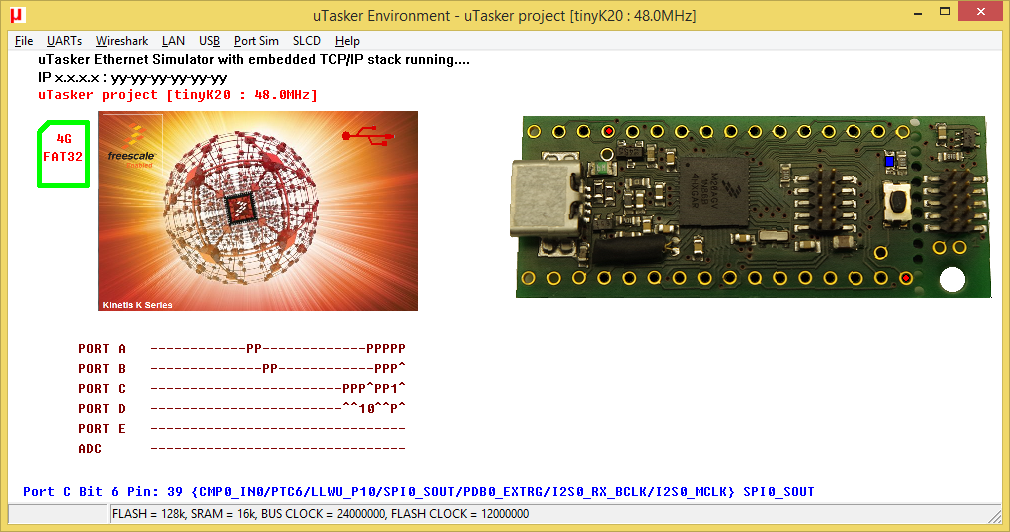tinyK20

This tinyK20 board is based on the MK20DX128VFT5 which is a 50MHz device from the performance and integration K20 family with Cortex-M4 core and USB. This K20 device has 128k Flash and 16k SRAM, as well as 32k FlexNVM and is in a 64 pin LQFP package, whereby the K20 is also available in various other packages (32, 48, 80, 100, 121 and 144 pin QFN, WLCSP, LQFP and MAPBGA combinations), speeds (50MHz, 100MHz and 120MHz) and its memory ranges from 8k .. 1M Flash and 8k .. 128k SRAM. There is an 8MHz crystal on the board for clocking the part.
Full details and documentation for this board can be obtained from : tinyK20 Open Source ARM Debug/Universal Board
To configure the µTasker project for this board simply enable the define tinyK20 in the project's config.h file. The compiler needs to be set to build for Cortex M4 (and not Cortex M0+) and the linker script K_128_16.ld should be selected [K_128_16_BM.ld for downloadable version] {the linker script extension may vary for different compilers, whereby *.ld is valid for GCC}
tinyK20 Binaries
Here are some binary files that can be loaded to the board. These were built using the µTasker applications (serial loader and V1.4 application) and can be simply generated using the supported compilers/IDEs, built using different configuration options or modified to suit specific requirements or hardware derived from this board :
- uTaskerSerialBoot_tinyK20_KBOOT_HID_MSD.bin KBOOT compatible USB-HID loader with composite USB-MSD loading as well [13.5k] allowing applications to be loaded at link address 0x8080 (using Freescale's KBOOT USB connection or USB-MSD when the board appears as upload hard disk). When operating, the blue LED blinks at 5Hz. To force the loader reset the board with header pin 27 [PTB0] connected to GND. To disable the watchdog reset the board with pin 28 [PTB1] connected to GND. This can be loaded using CodeWarrior's flash loader (or other similar techniques) via its SWD interface. Note that the loader limits application sizes to 64k - it can be built without limits using the µTasker project.
-
uTaskerV1.4.10_BM_tinyK20_8080.bin tinyK20 application with command-line menu on the virtual COM connection with various menu items such as controlling low power modes. The USB device is a composite USB-CDC and USB-MSD to SD card. A second, read-only virtual disk is also included (appears as DATADISK 2) which allows the internal SRAM and Flash program space to be viewed - see µTasker - FAT Emulation for more details about FAT emulation. Note that the FlexNVM is used as 32k data flash for parameter storage. Drivers that can be used for this device are available below. The processor runs at 48MHz [58.8k].
Linked to 0x8080, this binary image can be loaded with drag-and-drop onto the upload disk that appears when the serial loader is operating or using the KBOOT loader's USB connection. When the application is running the blue LED blinks at 2.5Hz. - uTaskerV1.4.10_tinyK20.bin The same tinyK20 application as stand-alone software that can be loaded using a program adapter [59.8k].
- uTaskerFreescaleMultiVirtualCOMx1.inf.inf USB composite CDC/MSD installation file for 32-bit windows.
- uTaskerFreescaleMultiVirtualCOMx1_64bit.inf USB composite CDC/MSD installation file for 64-bit windows. See the following for a guide to installing unsigned drivers on Windows 8.1
Return to the Kinetis landing page
µTasker Kinetis tinyK20 support. Copyright (c) 2004..2018 M.J.Butcher Consulting